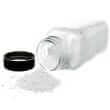Background
- Sodium bicarbonate is created from a reaction between sodium chloride, ammonia, and carbon dioxide in water. It easily dissolves in water, but not in alcohol, according to some sources.
- Sodium bicarbonate is also called baking soda and has been used to treat ulcers and upset stomach. There is strong evidence supporting the use of sodium bicarbonate for preventing kidney disease or damage caused by contrast dye used during medical imaging. The use of sodium bicarbonate for relieving pain associated with the injection of anesthesia is also supported by strong scientific evidence. There is good evidence supporting the use of sodium bicarbonate for the removal of earwax. Sodium bicarbonate has also been used to remove dental plaque and treat conditions such as diarrhea, poisoning, and excess acid in body fluids. Strong evidence in support of other uses is lacking. There may be negative side effects associated with sodium bicarbonate when used to revive people from unconsciousness or to treat excess acid in the body fluids.
- Overall, more research is needed on the safety of sodium bicarbonate.
References
Natural Standard developed the above evidence-based information based on a thorough systematic review of the available scientific articles. For comprehensive information about alternative and complementary therapies on the professional level, go to www.naturalstandard.com. Selected references are listed below.
- Briguori C, Visconti G, Ricciardelli B, et al. Renal insufficiency following contrast media administration trial II (REMEDIAL II): RenalGuard system in high-risk patients for contrast-induced acute kidney injury: rationale and design. EuroIntervention. 2011;6(9):1117-22, 7. View Abstract
- Carr AJ, Hopkins WG, and Gore CJ. Effects of acute alkalosis and acidosis on performance: a meta-analysis. Sports Med. 10-1-2011;41(10):801-814. View Abstract
- Glisson JK, Vesa TS, and Bowling MR. Current management of salicylate-induced pulmonary edema. South.Med.J. 2011;104(3):225-232. View Abstract
- Joannidis M, Druml W, Forni LG, et al. Prevention of acute kidney injury and protection of renal function in the intensive care unit. Expert opinion of the Working Group for Nephrology, ESICM. Intensive Care Med. 2010;36(3):392-411. View Abstract
- Kleinman ME, Chameides L, Schexnayder SM, et al. Part 14: pediatric advanced life support: 2010 American Heart Association Guidelines for Cardiopulmonary Resuscitation and Emergency Cardiovascular Care. Circulation 11-2-2010;122(18 Suppl 3):S876-S908. View Abstract
- Kunadian V, Zaman A, Spyridopoulos I, et al. Sodium bicarbonate for the prevention of contrast induced nephropathy: a meta-analysis of published clinical trials. Eur.J.Radiol. 2011;79(1):48-55. View Abstract
- Meier PP and Gurm HS. Is simpler also better? Brief sodium bicarbonate infusion to prevent contrast-induced nephropathy. Am.J.Cardiol. 4-1-2010;105(7):1042-1043. View Abstract
- Neumar RW, Otto CW, Link MS, et al. Part 8: adult advanced cardiovascular life support: 2010 American Heart Association Guidelines for Cardiopulmonary Resuscitation and Emergency Cardiovascular Care. Circulation 11-2-2010;122(18 Suppl 3):S729-S767. View Abstract
- Parekh R, Care DA, and Tainter CR. Rhabdomyolysis: advances in diagnosis and treatment. Emerg.Med.Pract. 2012;14(3):1-15. View Abstract
- Raghuveer TS and Cox AJ. Neonatal resuscitation: an update. Am.Fam.Physician 4-15-2011;83(8):911-918. View Abstract
- Silva RG, Silva NG, Lucchesi F, et al. Prevention of contrast-induced nephropathy by use of bicarbonate solution: preliminary results and literature review. J.Bras.Nefrol. 2010;32(3):292-302. View Abstract
- Thomas R. Towards evidence based emergency medicine: best BETs from the Manchester Royal Infirmary. Bet 1. Rhabdomyolysis and the use of sodium bicarbonate and/or mannitol. Emerg.Med.J. 2010;27(4):305-308. View Abstract
- Thong S, Hooper W, Xu Y, et al. Enhancement of plaque removal by baking soda toothpastes from less accessible areas in the dentition. J.Clin.Dent. 2011;22(5):171-178. View Abstract
- Trivedi H, Nadella R, and Szabo A. Hydration with sodium bicarbonate for the prevention of contrast-induced nephropathy: a meta-analysis of randomized controlled trials. Clin.Nephrol. 2010;74(4):288-296. View Abstract
- Zaraca F, Wiedermann CJ, and Ebner H. Contrast media-induced nephropathy in patients undergoing angiography prior to or during vascular surgery: a systematic review. Minerva Chir 2011;66(6):553-560. View Abstract







